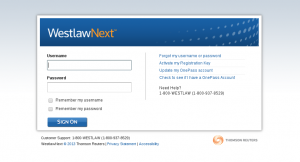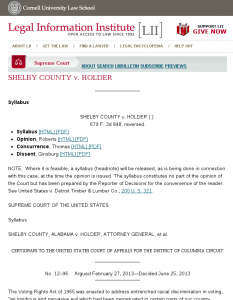I spend a lot of time working on and thinking about free and open access to the law, mostly court opinions. Today1» the Supreme Court of the United States handed down a decision in Shelby County v. Holder. The opinion strikes down a section of the Voting Rights Act and will certainly trigger much discussion, debate, and possibly legislation going forward.
I’ll leave analysis of the decision to others and instead point out a graphic demonstration of the power of free and open access to the law. I think we can all agree that Shelby is going to have an impact on voting in America. Now this decision is the law of the land. Everyone needs to know about it. Access to the decision needs to be free and open. As soon as the opinion was issued it began cropping up on the web. Links were being posted to Twitter:
SHELBY COUNTY v HOLDER, now on #Westlaw 2013WL3184629 #SCOTUS #VRA http://t.co/ISt5Fy6iFL
— Thomson Reuters Westlaw (@Westlaw) June 25, 2013
Supreme Court decides SHELBY COUNTY, AL v. HOLDER, ATT'Y GEN., ET AL.. Decided 06/25/2013 http://t.co/x83NL5JopH #SCOTUS
— LII @ Cornell Law (@LIICornell) June 25, 2013
Following the links in these tweets provided interesting results that provide a graphic highlight of what free and open access to the law looks like. Clicking on the link in the Westlaw tweet gives the user this:
 On the other hand clicking on the link in the LII tweet gets us to a better place:
On the other hand clicking on the link in the LII tweet gets us to a better place:
I understand that WestlawNext is a commercial service owned and operated by Thomson Reuters, but this document is law that applies to everyone in the United States. If you are going to link to it in a public space at least put the text of the opinion in from of the paywall so everyone seeing your link can read the opinion. Save the login for all of the extra value your products bring to the analysis of the decision.
I also understand that all too frequently our access to the law that governs our country is restricted by commercial interests who have little or no incentive to freely and openly distribute the law. Our law protects our freedom and our law needs to be free2» and open for all to readily access.



